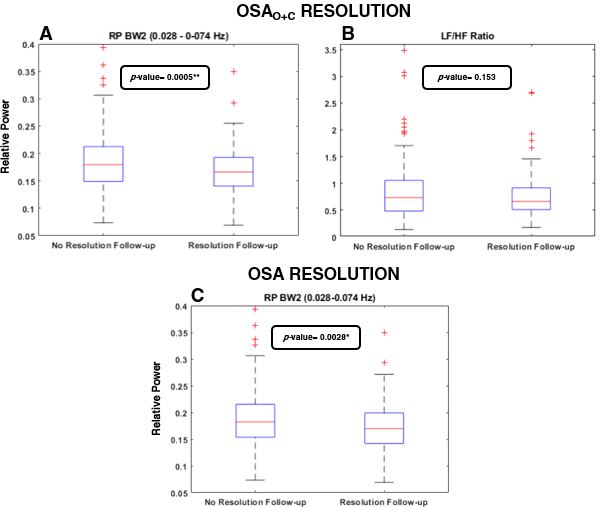Heart Rate Variability as a Potential Biomarker of Pediatric Obstructive Sleep Apnea Resolution
In this post we feature work from the following publication:
Adrián Martín-Montero, Gonzalo C Gutiérrez-Tobal, Leila Kheirandish-Gozal, Fernando Vaquerizo-Villar, Daniel Álvarez, Félix del Campo, David Gozal, Roberto Hornero, Heart rate variability as a potential biomarker of pediatric obstructive sleep apnea resolution, Sleep, Volume 45, Issue 2, February 2022, zsab214, https://doi.org/10.1093/sleep/zsab214
Overview
What is the problem being addressed?
Pediatric obstructive sleep apnea (OSA) is a highly prevalent respiratory disorder that has been linked to increased cardiovascular risk. Changes in classic heart rate variability (HRV) parameters after pediatric OSA treatment have been previously reported, but these variations were not causally attributable to treatment outcomes. Furthermore, HRV approaches to assess OSA resolution have not been previously explored.
What was the approach to solving the problem?
In a previous work, we identified three specific frequency bands (named BW1, BW2 and BWRes) in OSA. As changes in classical HRV parameters occurs, but are not causally attributable to OSA treatment, we decided to perform causal mediation analysis in the specific OSA frequency bands too. Furthermore, changes in HRV parameters have not been evaluated as reporters of OSA resolution. Thus, we hypothesized that changes with treatment in the three specific spectral bands can reliably identify changes in OSA severity and reflect OSA resolution
What NSRR data were used?
Overnight electrocardiogram of 404 children from the prospective Childhood Adenotonsillectomy Trial; 206 underwent early adenotonsillectomy (eAT), while 198 underwent watchful waiting with supportive care (WWSC). All the children completed a baseline and follow-up polysomnography after treatment.
What were the results?
Treatment, regardless of eAT or WWSC, causally affects HRV activity, mainly in the novel OSA specific frequency band BW2 (0.028-0.074 Hz). Furthermore, only changes in BW2 were specifically attributable to all OSA resolution mediators considered (first considering only obstructive events, and then adding central apneas to the resolution criteria). HRV activity in BW2 also showed statistically significant differences between resolved and non-resolved OSA children (p-value < 0.01).
What were the conclusions and implications of the work?
This research work shows that changes in specific HRV parameters specifically identify OSA treatment outcomes. Furthermore, HRV activity in BW2, a specific apnea-related spectral band, differentiates children with and without OSA resolution after treatment. Thus, our results highlight BW2 as a potential biomarker of OSA resolution.
Paper Summary
The Childhood Adenotonsillectomy Trial (CHAT) was a prospective randomized clinical trial designed to evaluate the efficacy of pediatric obstructive sleep apnea (OSA) treatment with early adenotonsillectomy (eAT) versus a watchful waiting with supportive care (WWSC) strategy. The original study showed that, interestingly, half of the children who underwent WWSC experimented OSA resolution, and only a proportion of children in the eAT group resolved OSA. These preliminary results have led to other researchers analyzing the CHAT database focusing on OSA resolution rather than the intervention. Heart rate variability (HRV) signal assesses cardiac health and provides a better understanding of autonomic nervous system. Pediatric OSA has been proved to alters cardiac dynamics, but while changes in HRV classic parameters had been identified after OSA treatment, these changes were deemed as not causally attributable to OSA resolution or changes in OSA severity. However, changes in novel OSA-specific HRV spectral bands after treatment, as well as HRV ability to assess OSA resolution has not been evaluated. Based on the aforementioned considerations, we wanted to evaluate if changes in novel OSA-specific HRV spectral bands are causally attributable to treatment effects, and also to assess HRV ability to reflect OSA resolution. We selected 404 children from the CHAT database (206 eAT and 198 WWSC), who underwent a baseline overnight nocturnal polysomnography first, and later repeated a follow-up polysomnography following randomization (7 months later). HRV changes in classical and OSA-related frequency bands from baseline to follow-up were computed. Using a causal mediation analysis, we evaluated OSA resolution (considering obstructive events first, and adding central apneas later) and changes in OSA severity as the causal pathways through which treatment influence HRV changes. This methodology allowed us to obtain robust causal mediation effects on HRV activity due to treatment, regardless of eAT or WWSC, primarily affecting the OSA-specific HRV frequency band BW2 (0.028-0.074 Hz). In addition, HRV activity in BW2 range was the only parameter that showed statistically significant differences between resolved and non-resolved OSA. Hence, our results establish that OSA treatment influences changes in HRV in terms of changes in severity and OSA resolution, mainly in the specific OSA BW2 frequency band. Thus, we propose the use of BW2 spectral band as a potential biomarker of pediatric OSA and its resolution after treatment.
*Figure caption: Differences at follow-up between children with and without resolution considering both OSA resolution approaches (when only including obstructive events, OSA resolution, and adding central events, OSAO+C resolution). Only those parameters that showed significant causal mediation effects with resolution mediators were evaluated. (A) Differences in the relative power in BW2 (RPBW2) considering OSAO+C resolution. (B) Differences in the low frequency/high frequency ratio (LF/HF Ratio) considering OSAO+C resolution. (C) Differences in RPBW2 considering OSA resolution. *